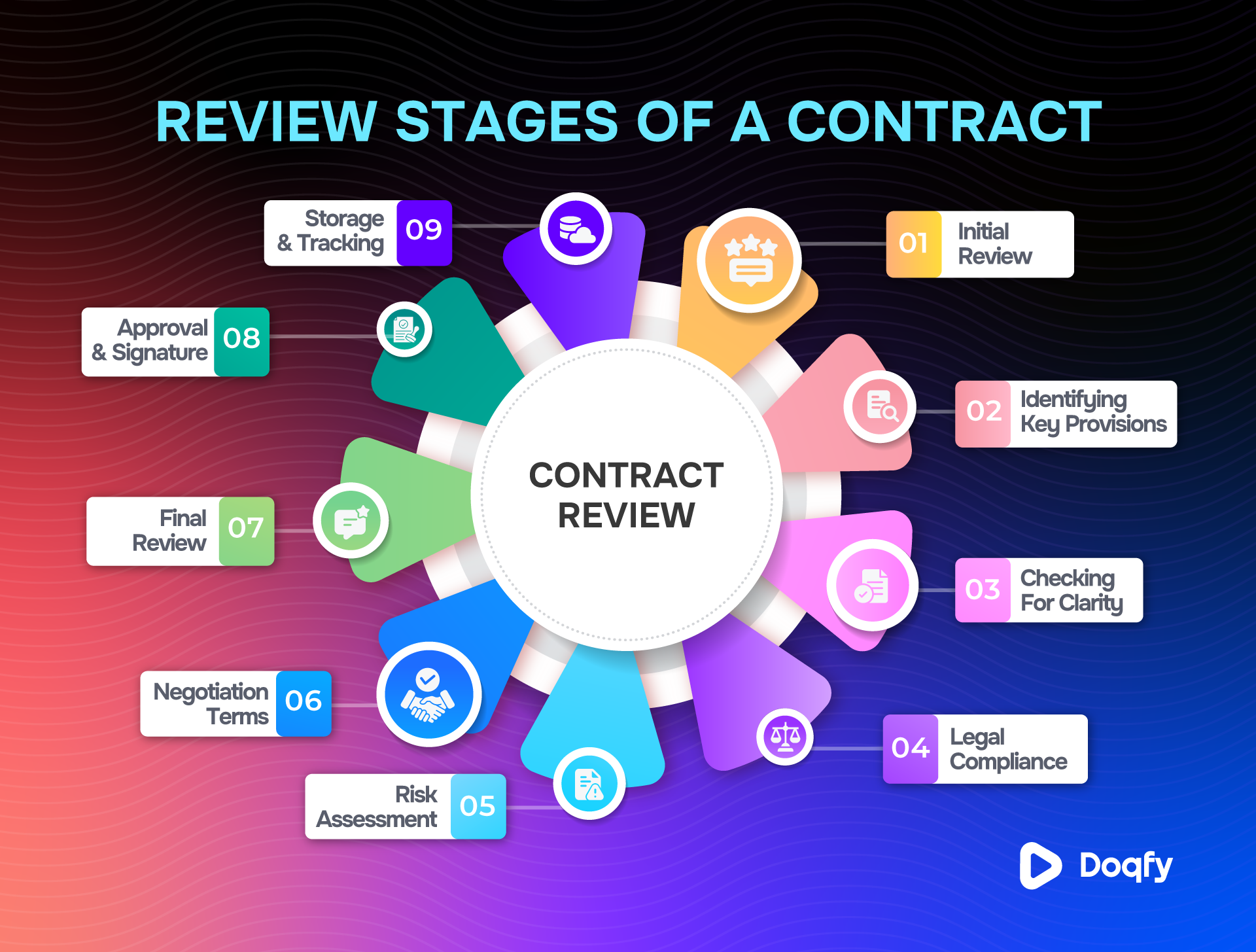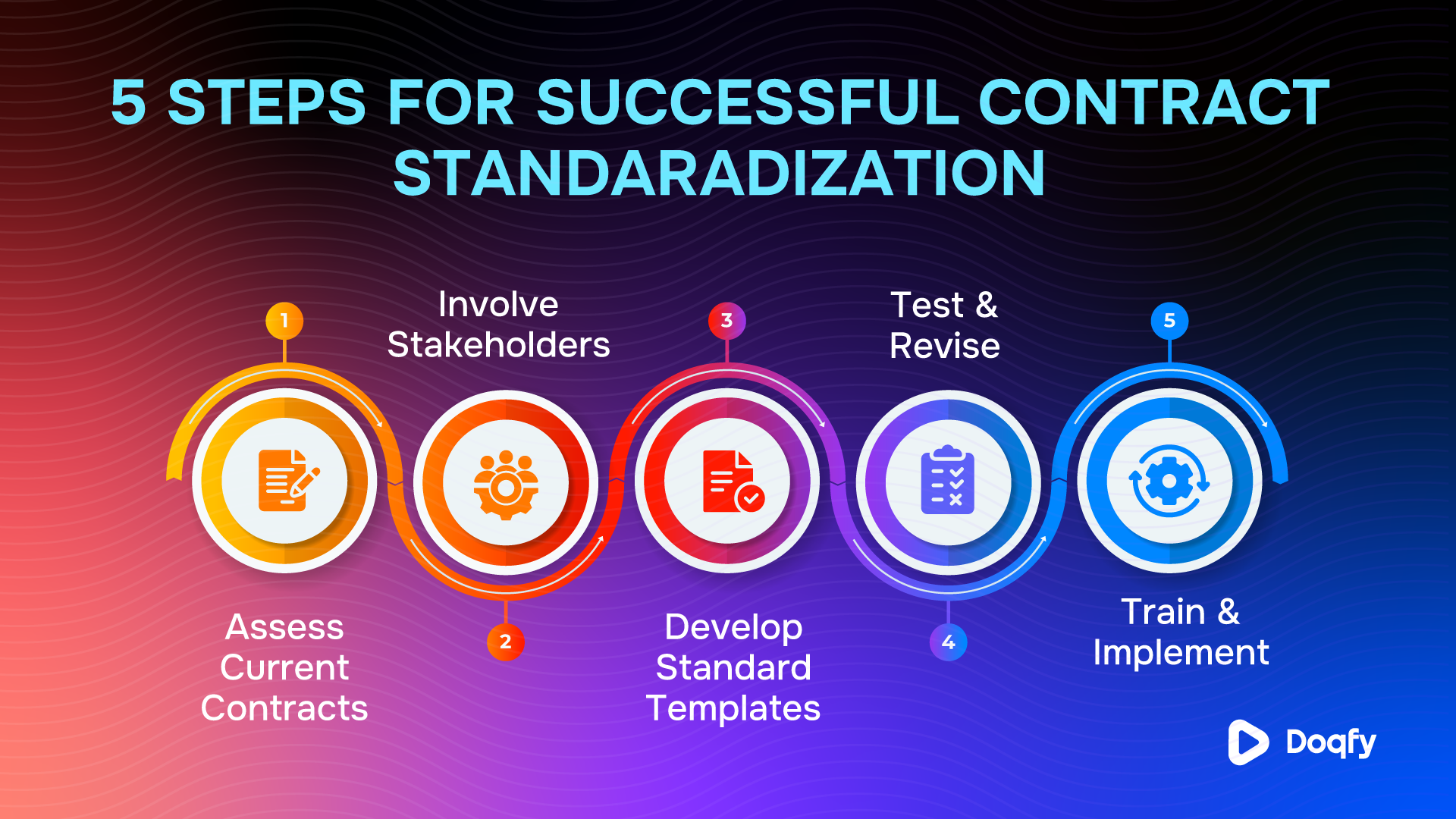The Need for Contract Standardization in CLM
Why Your Contracts Are Costing You Millions (And How Standardization Saves Them)

Legal professionals spend an average of 92 minutes reviewing and administering a simple $6,900 contract, making it one of their most demanding tasks. Now, consider the impact of a heavy workload, multiply that cost across multiple contracts, and see how it adds up.
That's a significant expense, isn’t it? What’s the solution? The answer lies in returning to Contract Lifecycle Management (CLM) basics. The review process of a typical CLM consists of the following stages.

Contract standardization can significantly improve most of these stages by maintaining consistency, clarity, and efficiency and reducing time and human errors in the contract management cycle. Now, let’s explore what standardization is and how to achieve it in CLM.
1. Contract Standardization 101: What You Need to Know
Contracting allows companies to use contracts for various purposes. Some contracts are uniform, while others must be customized to meet specific business needs. Contract standardization involves creating predefined templates based on previously successful and approved contracts. This practice is particularly beneficial for contracts that require minimal amendments or negotiation, as these templates are typically non-negotiable.
2. Finding the Perfect Fit: Contracts That Benefit from Standardization
Some contracts are better off being standardized than others. A few factors can help us identify them.
Low Risk
Low-risk contracts usually have clear terms and aren’t likely to lead to negotiations or disputes. That’s why we often use a standardized approach to speed things up and keep everything efficient and consistent. This approach is especially true for routine agreements, like NDAs or simple service contracts, where the stakes aren't that high.
Low value
These contracts usually involve minimal financial stakes. When the potential revenue or risk is low, there's less need for lengthy negotiations. For instance, purchase orders for everyday supplies don’t usually require much back-and-forth, so businesses can use standardized templates to save time and resources.
High volume
Standardization benefits organizations that often deal with similar agreements. High-volume contracts, such as vendor agreements or service contracts, involve many repetitive processes. Using standardized templates helps companies handle these agreements more efficiently, speeding up processes and reducing administrative load.
Simple terms
Contracts with straightforward terms and conditions are ideal for standardization. When agreements don’t require extensive negotiation or complex clauses, using a template streamlines the process for everyone. For instance, simple service agreements with clearly defined deliverables can be easily standardized, enabling businesses to finalize contracts quickly without getting bogged down in lengthy discussions.
3. Your Roadmap to Standardizing Contracts

Assess Current Contracts
Start by reviewing your existing contracts closely. It will help you spot common elements, language, and terms in different agreements. By identifying repetitive contracts, you’ll better understand your organization’s contracting landscape and see where standardization could be beneficial.
Develop Standard Templates
Create clear and concise templates for each type of contract. Include essential clauses like payment terms, deliverables, and termination conditions. Focus on legal compliance and clarity to reduce confusion and facilitate negotiations.
Involve Stakeholders
Collaborate with stakeholders such as legal, procurement, and other relevant departments to gather their input and insights. Getting everyone on board ensures that your templates meet all necessary legal and operational requirements, which can help smooth the way for adopting standardized contracts.
Test & Revise
Try the new templates in real-world situations to see how well they work. Gather user feedback regarding usability and clarity, and be ready to adjust based on their experiences. This iterative approach helps fine-tune the templates to meet your organization’s needs effectively.
Train & Implement
Once your templates are finalized, provide thorough training for employees on how to use them effectively. Store the templates in a centralized location that’s easy to access so everyone involved can consistently utilize them and adhere to the standardized approach.
4. The Many Perks of Contract Standardization
There are still many benefits, regardless of whether you can negotiate the standard contracts or not.
Increased Efficiency
Standardized templates make the contract creation process much smoother, saving time on drafting and approvals.
Consistency and Clarity
Uniform contracts help ensure the same terms and conditions throughout, reducing confusion and misunderstandings.
Reduced Errors
Sticking to pre-approved language reduces the chances of human error, resulting in more accurate and reliable contracts.
Faster Turn Around Times
With templates ready to go, businesses can execute contracts quickly, leading to quicker decision-making and better operational flow.
Cost Savings
Less time spent negotiating and fewer mistakes translate into lower legal and administrative costs, increasing overall profitability.
Improved Compliance
Standard contracts can be designed to meet necessary legal and regulatory requirements, helping businesses avoid compliance issues.
Easier Training
New employees can get up to speed faster when they only have to learn a set of standardized templates instead of navigating many different contracts.
Scalability
As your business grows, it’s easy to replicate and adapt standardized contracts for new clients or vendors, making expansion simpler.
Focus on Strategic Agreements
With routine contracts taken care of, teams can spend more time negotiating and strategizing on the complex agreements that really need their focus.
Improved Risk Management
Standardized contracts help identify common risks and liabilities, allowing businesses to address them proactively.
5. Final Thoughts
Contract standardization is key for organizations looking to enhance their Contract Lifecycle Management. By using clear and consistent templates, businesses can navigate the contract creation process more efficiently. It not only improves communication among teams but also ensures that everyone is on the same page regarding the terms and conditions.
Standardized contracts streamline new client and vendor onboarding as organizations look to expand. This approach also allows teams to focus on more complex negotiations that need undivided attention. By prioritizing standardization, businesses can boost their overall operational effectiveness. Ultimately, this strategy prepares organizations to tackle future challenges with greater agility and confidence.
If you need a CLM software to help standardize your contracts, check out Doqfy. It provides predefined templates that are quick, easy to use, and compliant with regulatory standards.
Click here to book a demo now and see the magic with your own eyes.
References
- Enterprise Legal Reputation (ELR) Report | ONIT. (2025, April 8). Onit. https://www.onit.com/elr/
- World Commerce & Contracting. (2021). Can the contracting process improve without an owner? https://www.worldcc.com/Portals/IACCM/Resources/11030_0_KPMG-report-v6%20FINAL.pdf

